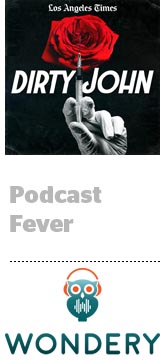
Podcast network Wondery is riding high into 2018.
Launched in 2016 by former Fox International Channels CEO Hernan Lopez, with backing from 20th Century Fox, Wondery produced its first breakout original hit last fall. “Dirty John,” a true crime mystery created with the LA Times, has been listened to over 15 million times since it debuted in October, with three million people tuning in to at least one full episode, Lopez said.
“[The LA Times] had written and reported most of the story already as a four-part article,” he said. “Together, we turned it into a six-part, multi-platform story, releasing every episode with a news story over a seven-day period.”
Being ranked number one on iTunes’ podcast app for 31-days straight helped keep up the momentum and draw new listeners to “Dirty John,” 77% of which were new to Wondery’s content.
But the nascent podcast industry has kinks to work out beyond attracting more listeners with great content. Lopez, part of the IAB committee that wrote the Podcast Measurement Guidelines last year, is committed to establishing better analytics, measurement and more efficient monetization in podcasting – without disrupting the premium listening experience.
He spoke with AdExchanger.
AdExchanger: How did you monetize “Dirty John”? Do you sell programmatically?
Primarily through advertising. We’re also paid a licensing revenue.
We don’t [buy programmatic]. Nobody I know [in podcasting] is doing it at scale. The data we use comes from listener surveys – age, gender, income, occupation and [location]. In 2018, I can see a universe where we target based on third-party data.
Do you fear programmatic will lower podcast CPMs?
I don’t see programmatic happening in podcasts the same way it happened in digital.
In digital, [ads that are bought] programmatically or [direct] look the same to the consumer. In podcasting, there’s a risk people will roll out programmatic with prerecorded ads. Companies have experimented injecting traditional radio commercials into podcasts and backtracked based on listener concern. Most large companies won’t do it.
A lot of podcast companies are excited about brand advertisers getting into the space. Are you working with big brands?
The [podcast] market gets about 70% of its revenue from direct response advertisers. In every other media, direct response tends to pay lower CPMs than branding, but in podcasts, they pay the same or higher. They know what works and tend to buy all the premium inventory as soon as it’s available.
Brands have been slower to the space because there’s a perception that there isn’t scale or research. Both of those have changed. One in three millennials listen to podcasts. Podcast listeners over-index for ad blockers, but they embrace ads on podcasts because they are, by and large, read by the hosts and native to the content.
How has Apple opening up its listener data made life easier for you as a producer? What else do you need to offer better analytics?
About two-thirds of our listening comes from Apple. We’re able to see minute-by-minute listening information for our shows. You can see what people skip and how long they listen. Based on that, we can improve the content. But, for the time being, that information is reserved only for publishers.
The IAB updated its podcast measurement guidelines late last year. How close is the podcast industry to adopting standards across the board?
Once the leading companies implement them, we’re going to get to a level playing field where everybody is speaking about the same numbers when it comes to a download. When Apple allows publishers to share [listener] data with advertisers and analytics companies, we can start to track the relation between listening patterns and results.
Beyond Apple, the podcast space is fragmented. Do you predict consolidation in 2018?
I can see Spotify and TuneIn increasing their share. Spotify is bringing new listeners to podcasts, so their entry to the marketplace is welcome. But in the medium-term, I can’t imagine Apple not accounting for the majority of listening.
An opportunity is Android users, which don’t have a pre-installed podcast app [on their phones]. I think Google will launch a Google podcast app, but they haven’t announced that.
What’s the biggest gap in the podcast industry right now?
Attribution. Let’s say you hear [the same] ad on 10 podcasts. You only have room for one [promo code]. Which are you going to enter? You have the effect of nine shows doing the work and one getting the credit, like what happens in digital. We’ll need a better way to close the attribution gap.
This interview has been edited.
This post was syndicated from Ad Exchanger.

More Stories
WPP’s Q1 Revenues Slide 5%, but Tariffs Aren’t to Blame
Revolving Door Roundup: Gary Tuchman Departs CNN After 35 Years
The Winners and Losers of Google’s Big Cookie Reversal